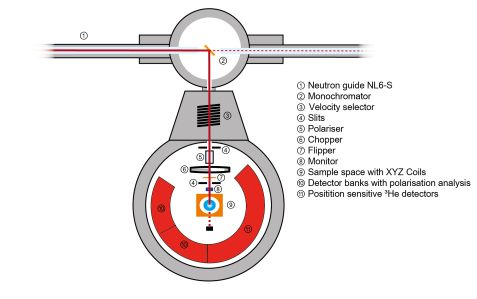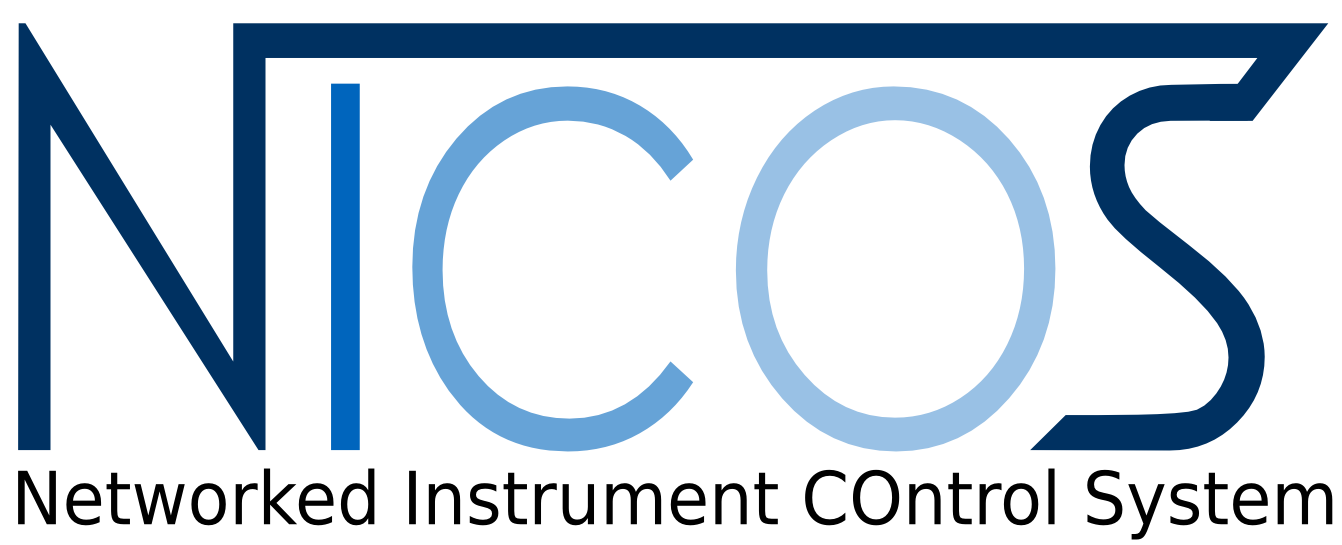MLZ is a cooperation between:
 > Technische Universität München
> Technische Universität München > Helmholtz-Zentrum Hereon
> Helmholtz-Zentrum Hereon
 > Forschungszentrum Jülich
> Forschungszentrum Jülich
MLZ is a member of:
 > LENS
> LENS > ERF-AISBL
> ERF-AISBL
MLZ on social media:

MLZ (eng)
Lichtenbergstr.1
85748 Garching
DNS
Polarised diffuse neutron scattering instrument with time-of-flight inelastic scattering option

This instrument is focussed on cold neutrons. Therefore, please carefully check the “Technical data WITHOUT cold source” section. Deviating parameters are in bold. The instrument team is happy to answer any further questions!
DNS is a versatile polarised neutron scattering instrument that is ideally suited to study both short-range and long-range magnetic correlations in quantum materials, strongly correlated electrons, unconventional superconductors, and functional magnetic materials.
In addition to the diffraction mode, DNS also provides an option with time-of-flight inelastic neutron scattering, which can be used to measure low-energy magnetic excitations.
With its compact size, a new-generation Fe/Si-based focussing polarising bender and wide-angle polarisation analysers, DNS is optimised as a high-intensity polarised instrument with medium resolution. It allows for the unambiguous separation of nuclear coherent, spin incoherent, and magnetic scattering contributions simultaneously over a large range of scattering vector Q and energy transfer E.
- Polarised powder neutron diffraction with the XYZ-method [1-3]
- Polarised single-crystal neutron diffraction [4]
- Magnetic diffuse scattering with polarisation analysis [5-7]
- Separation of nuclear coherent from spin incoherent scattering in soft condensed matter [8]
- Standard TOF option on powder samples (in commissioning) [9]
- Standard TOF option on single-crystal samples (under development)
- Polarised TOF option (under development)
[1] Z. D. Fu, et al., New J. Phys. 12, 083044 (2010).
[2] A. M. Hallas, et al., Phys. Rev. Lett. 113, 267205 (2014).
[3] V. Pecanha-Antonio, et al., Phys. Rev. B 96, 214415 (2017).
[4] F. Zhu, et al., Phys. Rev. Research 2, 043100 (2020).
[5] L. J. Chang, et al., Nat. Commun. 3, 992 (2012).
[6] S. Gao, et al., Nat. Phys. 13, 157 (2017).
[7] W. Schweika, et al., Phys. Rev. X 12, 021029 (2022).
[8] C. Gerstl, et al., Macromolecules 45, 7293 (2012).
[9] I. Zivkovic, et al., Phys. Rev. Lett. 127, 157204 (2021).
- Top-loading CCR and cryo-furnace: 4 – 400 K
- Orange-type cryostat: 1.5 – 300 K
- Dilution insert: Tmin ≈ 75 mK
- 3He insert: Tmin ≈ 500 mK
- Neutron guide NL6-S
- Horizontally and vertically adjustable, double-focussing
- PG(002), d = 3.355 Å
- Crystal dimensions: 2.5 × 2.5 cm2 (5 × 7 crystals)
- Wavelength range: 2.4 Å < λ < 3.5 Å
- Estimated flux
- Non-polarised: ~ 2 × 107 n cm-2 s-1
- Polarised: ~ 2 × 106 n cm-2 s-1
- Resolution Δλ/λ: 30 – 40 %
- Chopper frequency: ≤ 300 Hz
- Chopper disc: Titanium, 3 slits, Ø = 420 mm
- 128 position sensitive 3He tubes
- Ø = 1.27 cm, height ~100 cm
- Total solid angle covered: 1.9 sr
- Covered scattering angles in the horizontal plane: 0° < 2θ ≤ 135°
- 24 detection units:
- Polarisation analysis by m = 3 supermirror benders
- 3He detector tubes, Ø = 2.54 cm, height 15 cm
- Covered scattering angle in the horizontal plane: 0° < 2θ ≤ 135°
- Qmax
- λ[i ] = 2.4 Å (E[i ]= 14.2 meV): 4.84 Å-1
- λ[i ] = 3.5 Å (E[i ] = 6.7 meV): 3.32 Å-1
- λi = 2.4 Å (E[i ] = 14.2 meV): ~ 1 meV
- λi = 3.5 Å (E[i ] = 6.7 meV): ~ 0.5 meV
- Neutron guide NL6-S
- Horizontally and vertically adjustable, double-focussing
- PG(002), d = 3.355 Å
- Crystal dimensions: 2.5 × 2.5 cm2 (5 × 7 crystals)
- Wavelength range: 2.4 Å < λ < 6 Å
- Estimated flux
- Non-polarised: ~ 2 · 107 – 108 n cm-2 s-1
- Polarised: ~ 2 · 106 – 107 n cm-2 s-1
- Resolution Δλ/λ: 30 – 40 %
- Chopper frequency: ≤ 300 Hz
- Chopper disc: Titanium, 3 slits, Ø = 420 mm
- 128 position sensitive 3He tubes
- Ø = 1.27 cm, height ~100 cm
- Total solid angle covered: 1.9 sr
- Covered scattering angles in the horizontal plane: 0° < 2θ ≤ 135°
- 24 detection units:
- Polarisation analysis by m = 3 supermirror benders
- 3He detector tubes, Ø = 2.54 cm, height 15 cm
- Covered scattering angle in the horizontal plane: 0° < 2θ ≤ 135°
- Qmax
- λi = 2.4 Å (Ei = 14.2 meV): 4.84 Å-1
- λi = 6 Å (Ei = 2.27 meV): 1.93 Å-1
- λi = 2.4 Å (Ei = 14.2 meV): ~ 1 meV
- λi = 6 Å (Ei = 2.27 meV): ~ 0.1 meV
Instrument scientist
Dr. Yixi Su
Phone: +49 (0)89 158860-714
E-mail: y.su@fz-juelich.de
DNS
Phone: +49 (0)89 158860-502
Operated by

Funding

Publications
Find the latest publications regarding DNS in our publication database iMPULSE:
Citation templates for users
In all publications based on experiments on this instrument, you must provide some acknowledgements. To make your work easier, we have prepared all the necessary templates for you on this page.
Instrument control
Gallery






MLZ is a cooperation between:
 > Technische Universität München
> Technische Universität München > Helmholtz-Zentrum Hereon
> Helmholtz-Zentrum Hereon
 > Forschungszentrum Jülich
> Forschungszentrum Jülich
MLZ is a member of:
 > LENS
> LENS > ERF-AISBL
> ERF-AISBL
MLZ on social media:




